Tomato Rasam, quick and easy to make, with cooked yellow lentils/ thowar dal, tamarind extract, ripe tomatoes and rasam spice powder. Refreshing at all times, mixed with rice and with a suitable vegetable side which is what South Indians do. Delicious as soup on a chill evening.
This post was first published on 25th March 2020, and is now republished with updated content.
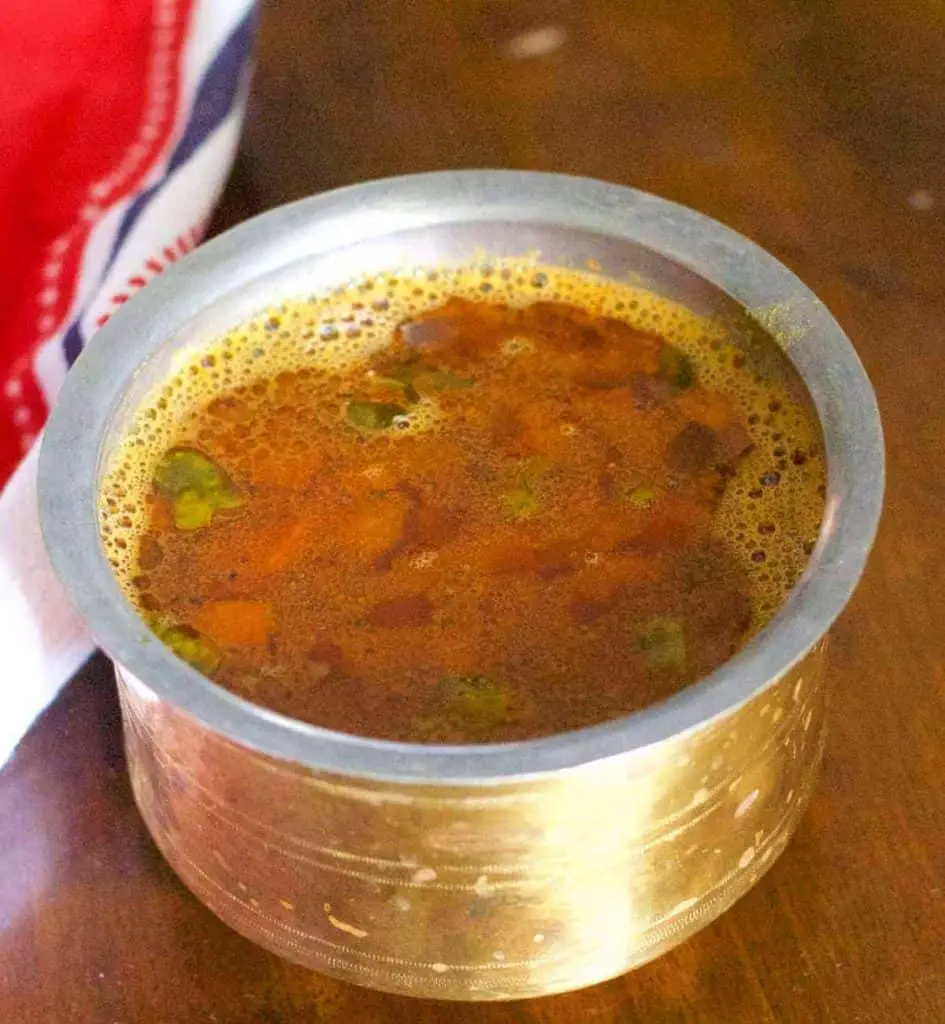
Spiced with coriander, asafoetida, chili, pepper and cumin and rich with juicy tomatoes, rasam is tasty and refreshing with hot rice and ghee, appalam or vadam and a dry sauteed poriyal/ sabzi. Rasam and rice are my go-to dish when I'm cooking in a hurry, or feeling a little low and I want comfort food, or there's a cold coming up, or I've been on a travel diet of roti, sabzi, dal, or when I get a foodie call from my Tamil origins!
Jump to:
My Recipe for Rasam Powder
Each family has its own recipe for homemade rasam powder or a preferred brand if store bought, within the broad contours of the preferences in its community. The rasam powder I use is this one from my recipe for homemade rasam powder, which faithfully follows my Mom's traditional tambrahm recipe. Rasam powder too has many varieties. Dry red chilies, towar dal and a smattering of other lentils, coriander seeds, black pepper, cumin seeds, asafoetida, curry leaves and turmeric are the usual ingredients for homemade rasam powder.
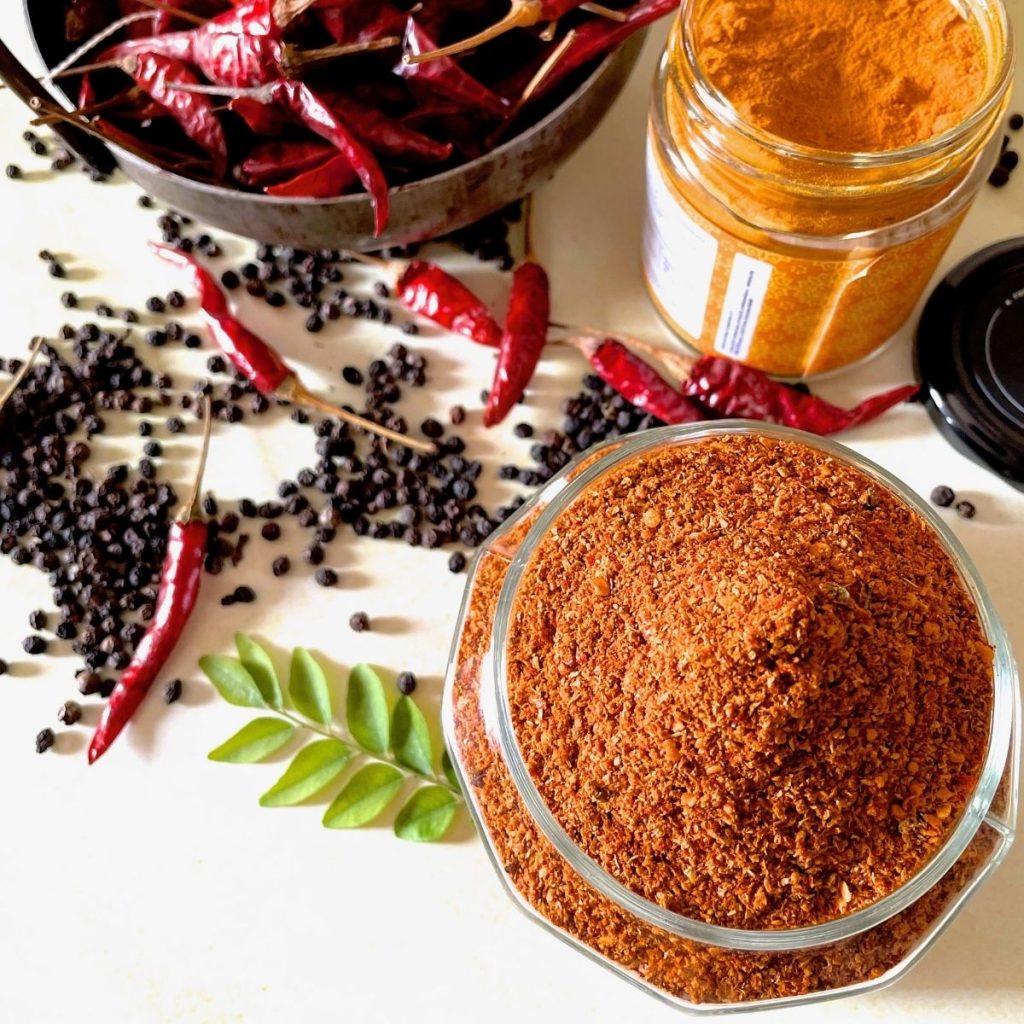
Other Rasam Varieties
Rasam, sambar, poriyal, kootu and kuzhambu are staples in a Tamil meal. Rasam is a fluid dish made usually from tamarind extract, lentils (arahar/ towar dal) and appropriate Indian spices, with a tempering of mustard seeds, cumin seeds and curry leaves at the end. There are many varieties of rasam with small and large differences in process and ingredients. Tamarind extract, rasam power, arahar/towar dal, other lentils, may or may not be used depending on the version.
Some further rasam recipes you will find in this blog are Lemon Thyme Rasam (my innovation and very refreshing in Summer), Pineapple Rasam (frequently served at Tamil weddings), Neem flower Mango Rasam for Tamil New Year, and Pathiya Milagu Jeera rasam as part of the post partum diet for new mothers after childbirth.
How To Make The Best Spicy Tomato Rasam
To make Tomato Rasam, tamarind extract is first boiled with rasam spice powder, asafoetida, curry leaves, tomato and salt, till the raw smell disappears. A little cooked dal is then mashed and added to the tamarind extract. Adding rasam powder directly to dal and then adding tamarind extract does not give the authentic results though it can be tasty too.
It is best to boil whole tomatoes separately before making rasam, and slice and add them along with the water in which they are boiled, as indicated in the recipe below.
If raw tomatoes are added directly to the rasam, the slices may be gently squeezed before adding to the tamarind extract, to release the juices.
Rasam powder gives all the spices needed for a flavourful aroma, along with mustard seeds and cumin seeds added while tempering.
A little extra jeera / cumin powder, preferably freshly ground, and fresh ground black pepper, in addition to rasam powder, gives the dish an even better aroma.
Curry leaves have nutrient properties, as explained in this article here.
They invariably get left on the side of the plate as no one wants to chew on them. I therefore mince the curry leaves and add them both while boiling the rasam and in the ghee while tempering. Mincing helps ensure they are actually consumed and all the nutrients are taken in!
More About This Recipe
Quantities in the recipe below are indicative, so please adjust the volume of rasam powder, to your taste.
Tomatoes may be pressure cooked along with the dal, or else boiled separately, or added raw to the tamarind extract. Instructions are given in the recipe below for each of these options.
The time taken is factored in the recipe for the tamarind being soaked while the dal is pressure cooked and the tomatoes are boiling simultaneously. If each of these activities are carried out one by one, the time is to be reckoned accordingly.
The Tadka / tempering of mustard seeds and cumin/ jeera seeds and curry leaves is with ghee rather than oil, for that special flavour.
Recipes For Side Dishes With Rasam:
Sambar and Kuzhambu Recipes
"Recipe"
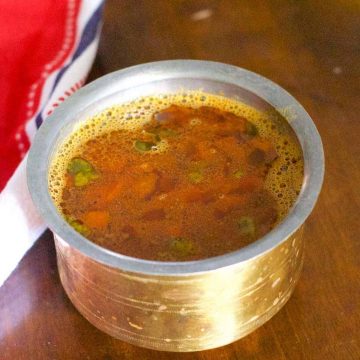
Spicy Tomato Rasam from Homemade Rasam Powder
Ingredients
For Soaking
- 2 tablespoons Tamarind pulp size of a small Indian lemon
- 1 cup Water
For Pressure Cooking
- ¼ cup Towar dal arahar dal/ towaram paruppu/ split pigeon pea lentils
- ¼ teaspoon Turmeric powder haldi powder
- 1 cup Water For cooking the dal
For Boiling
- 2 Tomatoes red and juicy
- ½ cup Water
For Making Tomato Rasam
- 2 tablespoons Rasam powder i. or to taste ii. click rasam powder for link to recipe
- ¼ teaspoon Cumin powder Freshly ground
- ¼ teaspoon Pepper powder Freshly ground
- 1 pinch Asafoetida hing
- 6 Curry leaves
- 1 tablespoon Coriander leaves minced
- ½ teaspoon Salt or to taste
- ½ cup Water if required/ optional
For tempering:
- 1 teaspoon ghee
- ¼ teaspoon Mustard seeds
- ¼ teaspoon Cumin seeds
- 6 curry leaves
Instructions
Preparation (Soaking of Tamarind to be done while the Dal is being Pressure cooked)
- Soak tamarind (about the size of a large marble or a small Indian lemon) in 1 cup of water.Tip: It is best to roll it into a ball and then soak in water, so that it is easily discarded once all the juice has been extracted. It is not pleasant to bite into a sour piece of tamarind!Soak the tamarind for at least 10 minutes. Tip: In cold climates, use warm water for soaking the tamarind.
- Mince (slice very small) the coriander leaves and shred (tear) the curry leaves.
Pressure Cooking Lentils and Boiling Tomatoes
- Meanwhile, wash the dal and add turmeric powder. Pressure cook till the dal is soft, in 1 cup of water. I cook it for 2 whistles and then let the cooker release pressure/ steam by itself.
- Either cook the whole tomatoes in the cooker along with the lentils, or else boil them separately in a small pan of water while the dal is being pressure cooked. Add tomatoes, bring the water to boil, and reduce the stove heat to medium or low to simmer for 10 minutes.Once done, remove from the stove, slice the tomatoes and add as per instructions below, along with the water in which boiled.
To Make Tomato Rasam
- Start once the cooker is ready to be opened and tomatoes are boiled.
- Extract the juice of the tamarind by squeezing it in the water in which it is soaked. Strain the tamarind extract into a bowl, checking that there are no pieces of tamarind pulp or seeds, pour into a pan and heat on the stove.Add another ¼ cup of water to the tamarind pulp and squeeze out any remaining juice. Add to the pan on the stove. Discard the used tamarind pulp. Tip:The used pulp is good for cleaning oily iron frying pans (kadai).
- To the tamarind extract on the stove, add sliced tomatoes along with water in which boiled, rasam powder, cumin powder, pepper powder, asafoetida powder, a few minced curry leaves and salt.
- Bring the rasam to a boil and then reduce the heat to low flame. Let it simmer for 5 - 7 minutes on low heat so that the raw smell of the tamarind and the chili in the rasam powder disappears. If tomatoes are added raw, give it another 2-3 minutes for them to boil, before going to the next step.
- Mash the cooked thowar dal in its own liquid so that the grains combine, and pour into the rasam.Bring to a boil, keeping it boiling for 2 minutes. Simmer on low flame for 3 minutes. Taste for correctness of salt. If the rasam is thicker than you would like, add ¼ -½ cup of water and bring to a boil.Add the chopped coriander and remove the pan from the stove.
Tempering
- Keeping the stove on low flame, heat ghee in a small tempering pan, add mustard seeds and let them burst. Add cumin seeds and after 10 secs, switch off the stove, quickly adding the minced curry leaves.Pour the ghee tempering on the rasam and keep the pan covered.
- Serve hot with rice and ghee, a sauteed poriyal/ sabzi and papad.


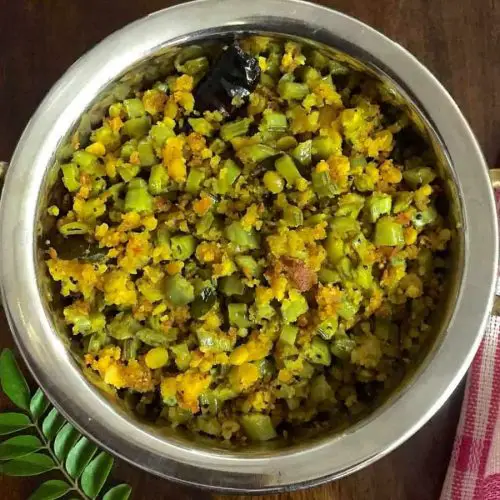
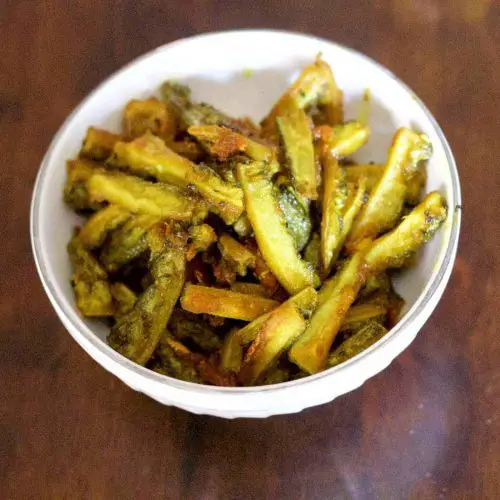
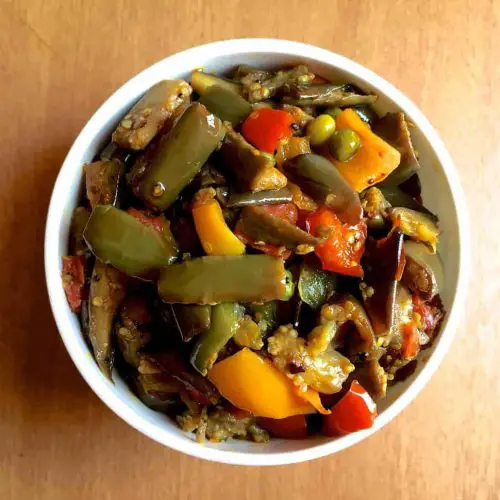
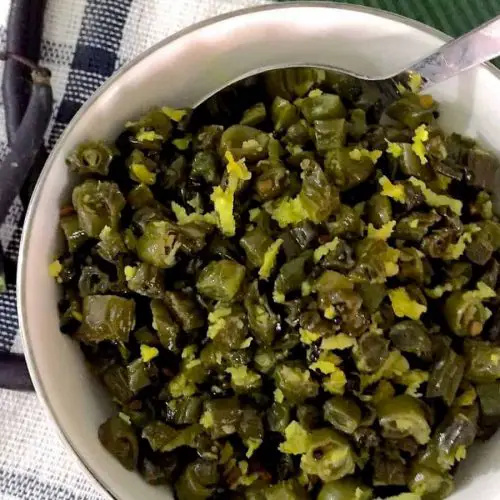
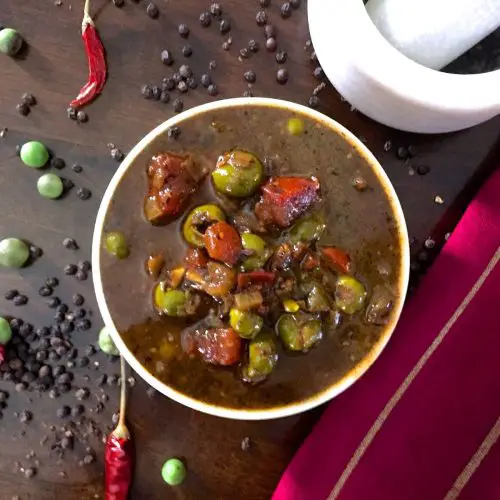
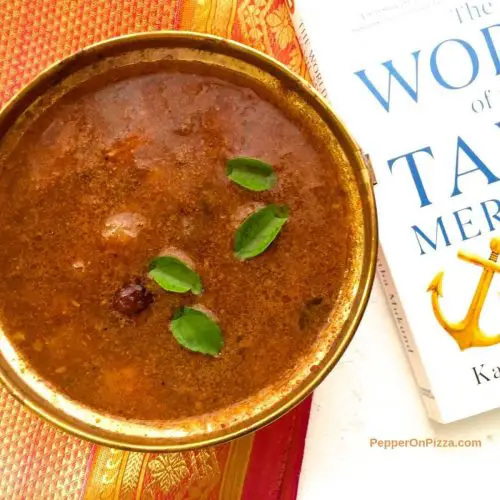
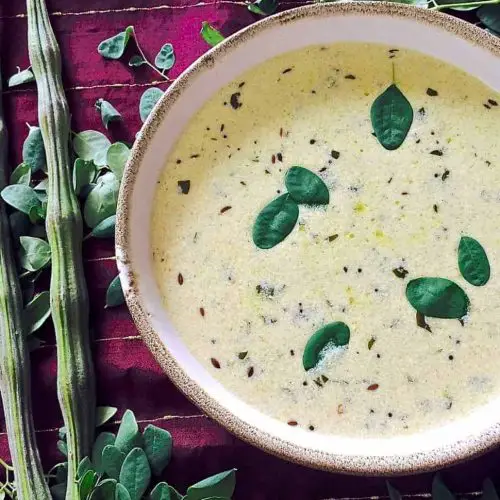

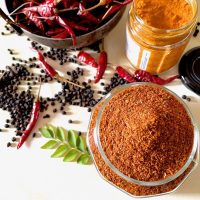
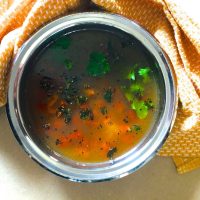
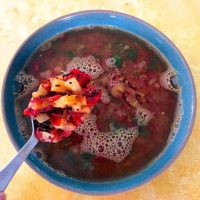
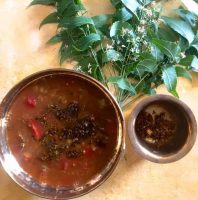
Sujata Shukla says
Recipe posted!
Cherian Thomas says
Recipe please